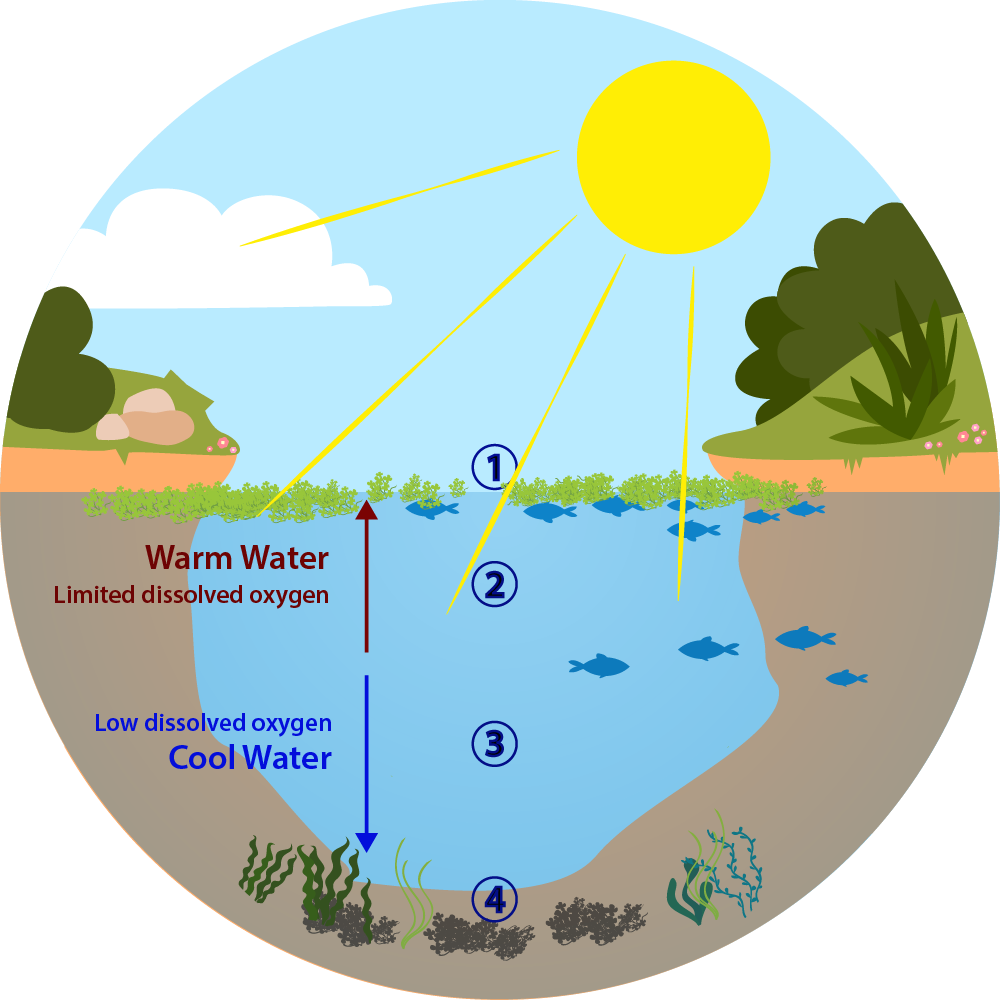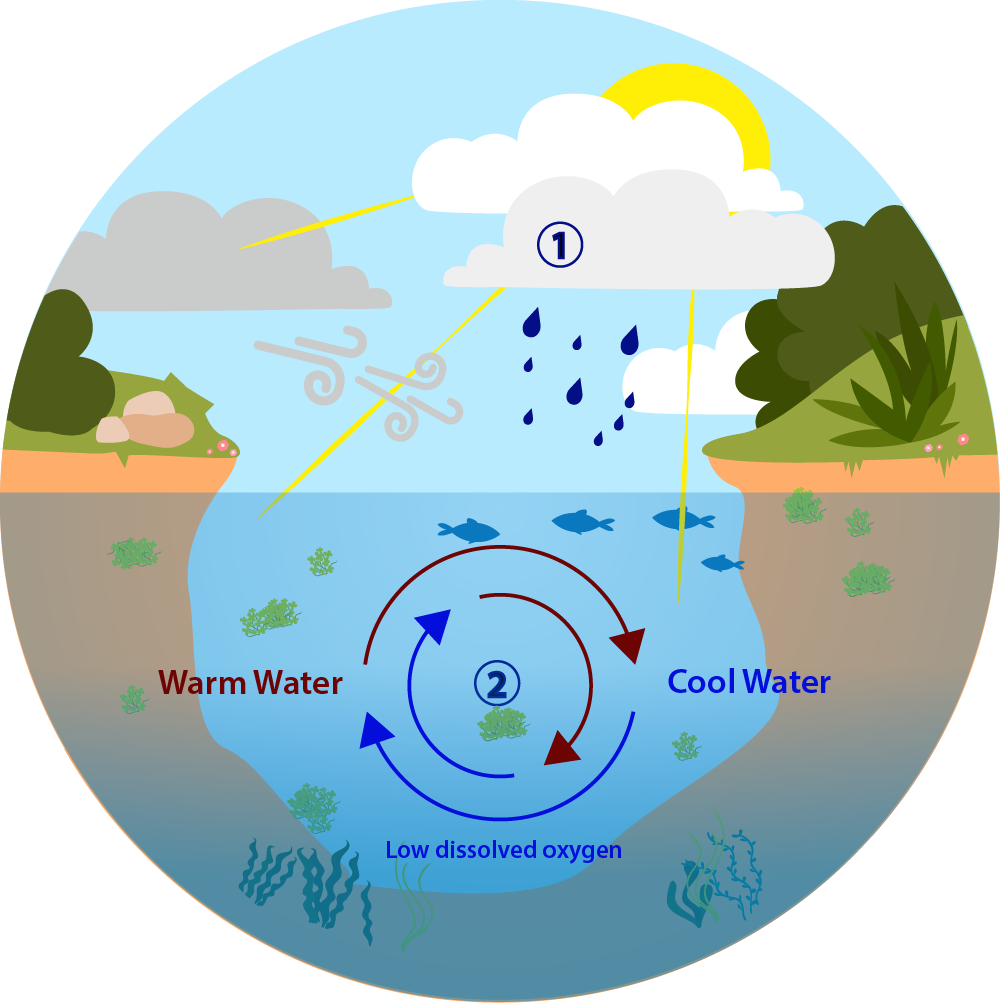
Fish kills in NSW 2021-2022
Please report any fish death incidents or observations to the Fishers Watch Phoneline on 1800 043 536
What are fish kills?
Fish kills are defined as a sudden mass mortality of wild fish.
Fish kills can occur at any time although data indicates fish kills are more likely to occur in summer or following sudden changes in temperature.
Recent reports of fish kills are included in the table below and we will update the table as we receive reports.
Some of the key causes of fish kills are outlined in the information below.
Blackwater
Blackwater occurs naturally over time when leaf litter and woody debris build up on the floodplain and then get washed into the river system during a flood. It’s an important part of the aquatic food web as it provides food for insects which feed fish, frogs and other aquatic wildlife.
When there is a prolonged dry period, the leaf litter and organic matter on the floodplain builds up until the next flood event. This can result in a significant amount of organic matter returning to the river with any big flushes of water after prolonged drought, making blackwater events more likely.
Hypoxic blackwater
When there is a lot of organic material washed into the river, its rapid decay can consume dissolved oxygen from the water. If dissolved oxygen drops to very low levels, this can cause ‘hypoxic’ water which can be stressful for native fish and can lead to fish kills.
More information on blackwater can be found on the MDBA website and in this factsheet by DPIE Environment, Energy and Science (NSW DPIE EES).
To notify the department of potential blackwater events email waterqualitydata@dpie.nsw.gov.au or to report a fish kill, contact the Fishers Watch Phoneline on 1800 043 536.
Bushfire impacts on native fish
Find information on the impacts of bushfires on native fish.
Stratification?
Stratification is when the surface of the water heats up more than the deeper water. That warmer layer tends to be warm and well-oxygenated compared to the deeper water that is colder and oxygen-depleted.
Thermal stratification
Key
- Blue Green Algal Bloom
Algal flourish in warm and still conditions, particularly in the absence of high flow - Surface Water Layer
Warm, high nutrient load from run off.
Dissolved oxygen by day, depletion overnight
Limited fish habitat - Deep Water Layer
Cooler, low light penetration, low dissolved oxygen (hypoxia), Poor fish habitat - Decomposition of organic matter
Depletes dissolved oxygen
De-stratification ("Turn over")
Key
- Sudden weather events or small increases in flow
Can mix the warmer surface water and cooler deep water – essentially breaking down the temperature stratification - These changes can mix the warmer surface water with cooler deep water
Algal blooms may also be disrupted, potentially increasing decomposition (and further depleting oxygen). This means even at the surface dissolved oxygen levels can become critical, killing fish.
Simple things you can do
- Be on the lookout for any changes in water quality - i.e. changes to the colour or odour of your local waterway and report them to us via the Fishers Watch Phoneline on 1800 043 536.
- Contact us on the phoneline if you observe any dead fish or fish starting to gasp at the water surfaces.
Investigating and reporting
Recent fish death events
Updated: 24 January 2022 (2pm)
Below are the fish kills that were investigated and confirmed by NSW DPI Fisheries.
- More information on the 2018/19 fish kill events.
- More information on the 2019/20 fish kill events
- More information on the 2020/21 fish kill events.
1 July 2021 - 30 June 2022
Location and date kill observed | Cause and extent |
|---|---|
Murray Darling catchments in NSW | |
| Lake Albert, near Wagga Wagga (19 January) | A small scale fish kill appears to have occurred in the outflow section of Lake Albert (northern end) where fish have become stranded following exit on recent high flows. Three (3) Golden Perch and five (5) juvenile Common Carp (introduced species) were affected. |
| Mirrool Creek, Griffith (13 January) | Report of 10s to 100s of dead fish. The majority of species were Common Carp (introduced species). The cause of the fish kill is attributed to large rainfall event the preceding days that inundated the floodplain and washed organic material into the waterway. As a result of the large volumes of organic material entering the waterway, a rapid reduction in dissolved oxygen levels occurred, commonly referred to as a hypoxic blackwater event. |
| Bundidgerry Creek, near Narrandera (10 January) | Reports were received of hundreds of dead fish, including observations that Murray Crayfish were walking out of the water. Species affected included: Murray Cod, Golden Perch, Bony Herring, Australian Smelt along with Murray Crayfish. Several introduced species including Carp and Redfin Perch were also affected. The cause of the fish kill is attributed to large rainfall event the preceding days that inundated the floodplain and washed organic material into the waterway. As a result of the large volumes of organic material entering the waterway, a rapid reduction in dissolved oxygen levels occurred, commonly referred to as a hypoxic blackwater event. DPI Fisheries staff attended and rescued and relocated almost 100 Murray Crayfish under collection permit to Narrandera Fisheries Centre for safekeeping until water quality improves, when they will be released back to Bundidgerry Creek. All rescued Murray Crayfish were returned to the waterway on 21 January. |
| Lake Cowal, (5 January) | Report of thousands of dead Carp (introduced species). Widespread flooding in the Lachlan Valley and associated organic material entering waterways is suspected to have impacted water quality, in particular low dissolved oxygen levels. |
| Darling-Baaka River, near Bourke (24 December) | Report of less than 10 dead Murray Cod. Widespread flooding in the northern Murray Darling Basin and associated organic material entering waterways resulted in the deoxygenation of the water and subsequent fish deaths. |
| Quipolly Creek, immediately downstream of Quipolly Dam (22 December) | Report of approximately 100 dead fish. Species affected included Golden Perch and Common Carp (introduced species). It's suspected that the affected fish washed over the spillway of Quipolly Dam during following high rainfall and became stranded on a series of pools downstream of the dam. Water quality in those pools deterioated in the following days leading to a reduction in dissolved oxygen. |
| Barwon River, near Brewarrina (22 December) | Report of approximately 18 dead fish. Species affected included Bony Herring and Golden Perch. Widespread flooding in the northern Murray Darling Basin and associated organic material entering waterways resulted in the deoxygenation of the water and subsequent fish deaths. |
| Darling-Baaka River, near Bourke (22 December) | Report of tens dead shrimp and yabbies. Widespread flooding in the northern Murray Darling Basin and associated organic material entering waterways resulted in the deoxygenation of the water and subsequent fish deaths. |
| Barwon River, near Bourke (21 December) | Report of hundreds of dead fish. Species affected included Murray Cod, Golden Perch, Bony Herring and Common Carp (introduced species). Widespread flooding in the northern Murray Darling Basin and associated organic material entering waterways resulted in the deoxygenation of the water and subsequent fish deaths. |
| Barwon River, near Collarenebri (19 December) | Report of 7 dead Murray Cod. Widespread flooding in the northern Murray Darling Basin and associated organic material entering waterways resulted in the deoxygenation of the water and subsequent fish deaths. |
| Gunidgera Creek, near Wee Waa (8 December) | Report of approximately 100 dead fish. Species affected included Bony Herring and Common Carp (introduces species). Widespread flooding in the Namoi Valley and associated organic material entering waterways resulted in the deoxygenation of the water and subsequent fish deaths. |
| Lower Gwydir River, Caidmurra Bridge (4 December) | Report of thousands of dead fish. Species affected included mostly Bony Herring, some Carp, and small numbers of Golden Perc and Spangled Perch. The cause has been attributed to the combination of recent warm weather, significant reduction in flow following flood (and associated carbon input) has likely resulted in a decline of Dissolved Oxygen (DO) below critical thresholds, especially in isolated locations such as table drains where fish have become stranded. |
Coastal catchments in NSW | |
| Darlington Park, Corindi near Coffs Harbour (17 January) | Report of thousands of dead fish. Species affected included Mullet and Bream. The suspected cause of the fish death is attributed to critically low dissolved oxygen generated by high rainfall washing organic material into the creek. High amounts of decaying organic material, combined with recent high temperatures, can significantly reduce Dissolved Oxygen (DO) available which is needed for native fish to breathe and survive. |
| Throsby Creek, Newcastle (17 January) | Report of 1000's of dead fish. Species affected include Flathead, Bream, Mullet, Eels, Whiting, Gobies, Sole and Silver biddies. The suspected cause of the fish kill is attributed to critically low dissolved oxygen generated by high rainfall washing organic material into the creek. High amounts of decaying organic material, combined with recent high temperatures, can significantly reduce Dissolved Oxygen (DO) available which is needed for native fish to breathe and survive. |
| Arrawarra Creek, near Coffs Harbour (16 January) | Report of hundreds of dead fish. Species affected include juvenile Flathead and Bream. The suspected cause of the fish kill is attributed to critically low dissolved oxygen generated by recent high rainfall washing organic material into Arrawarra Creek. Large amounts of decaying organic material, combined with recent high temperatures, can significantly reduce Dissolved Oxygen (DO) which is needed for native fish to breathe and survive. |
| Collingwood Beach, Moona Moona Creek near Jervis Bay (15 January) | Report of dead fish, species affected and cause unknown. |
| Meroo Lake, near Tabourie Lake (11 January) | Report of 1,000s of dead fish. Species affected included: Mullet, bream and eels. Meroo Lake is an Intermittently Closed and Open Lake and Lagoon (ICOLLs). The suspected cause of this event was Meroo Lake opening following a recent storm. Fish kills can occur when ICOLLs open, especially in shallow relatively perched systems like Meroo Lake. This is from the lake draining quickly, and rapidly exposing anoxic layers of the lower water column (a natural feature in coastal lakes). The fish kill may have also been exacerbated by the large tidal range experienced over the recent king tides, and the higher water temperatures over summer. |



